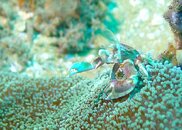Should I wait on buying an underwater camera until I have more dive experience ?
I am a newb diver so I was thinking on concentrating on being a better diver before I start trying to take photos
underwater as well.
Thanks All,
Barry
Several good answers here. I have about 40 years of shooting experience...above the water...and i learned to dive in spring of 2011. I have 94 dives to date and i have my advanced OW certification as well. I dive here in the philippines where a day of diving (two dives), including the boat and DM runs under $20, so i often dive 2 or more times a week.
I had your same questions. I have a nikon d 300 and a small kit. when i found out that a underwater housing for the body and lens would cost $1500 to $3,000, depending on lens. That put my underwater shooting on hold for at least the week it took to find alternatives. I now use what i call a "cheapo-cheapo" (it is compared to a nikon d300) canon g-12...their top point and shoot...and a canon housing. In the US you can probably get the whole outfit for $600 or so. It takes great shots and HD movies too. So the equipment to do at least semi serious work is available for less than the cost of your first born. Now to other things said...
If you jump in with a camera
without having decent control of your bouyancy, you will quickly see that you can't really shoot if you can't stay still. If you shoot on land, that just said statement is commonsensical. Boyancy control is the underwater equivalent of being able to stand still in the water. Imagine trying to shoot anything, even something standing still....if you are constantly rising or sinking. Just figeting around to have some semblance of staying in place will generate microcurrents that will alert/scare your subject.
You need basic control of bouyancy to be able to shoot any stills. You will need better than average control to shoot close-ups because depth of field is so shallow (pardon the pun). You will need very good control to shoot macros because depth of field is almost non existent. And though you can shoot some movies with less than good bouyancy control, as you get closer and closer to your subject, poor bouyancy control will result in movies that make your audience seasick in your living room.
The good news is that...even without a course...you will acquire better and better bouyancy control just as a result of experience, Even better news is that SDI...an i assume the other certification agencies....have mini courses that just deal with bouyancy. They are not expensive, give you a dive or to with an insturctor with a single purpose...no fun, just work. And you can take what you learn in those two dives and sharpen skills on your own.





